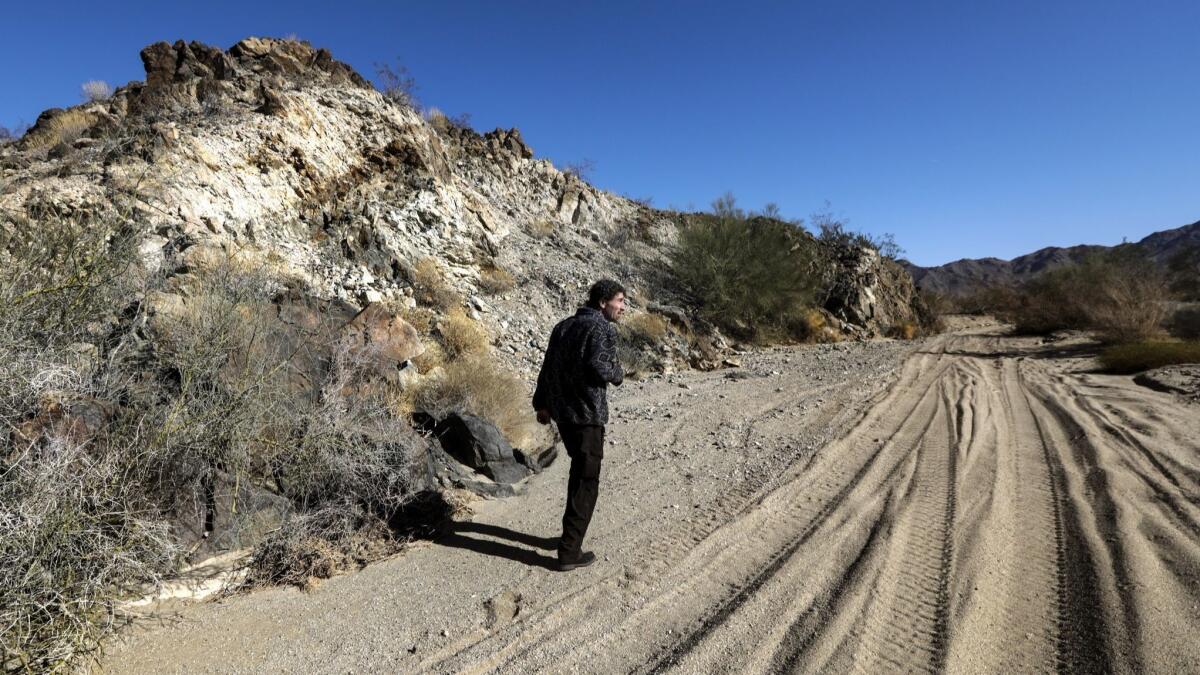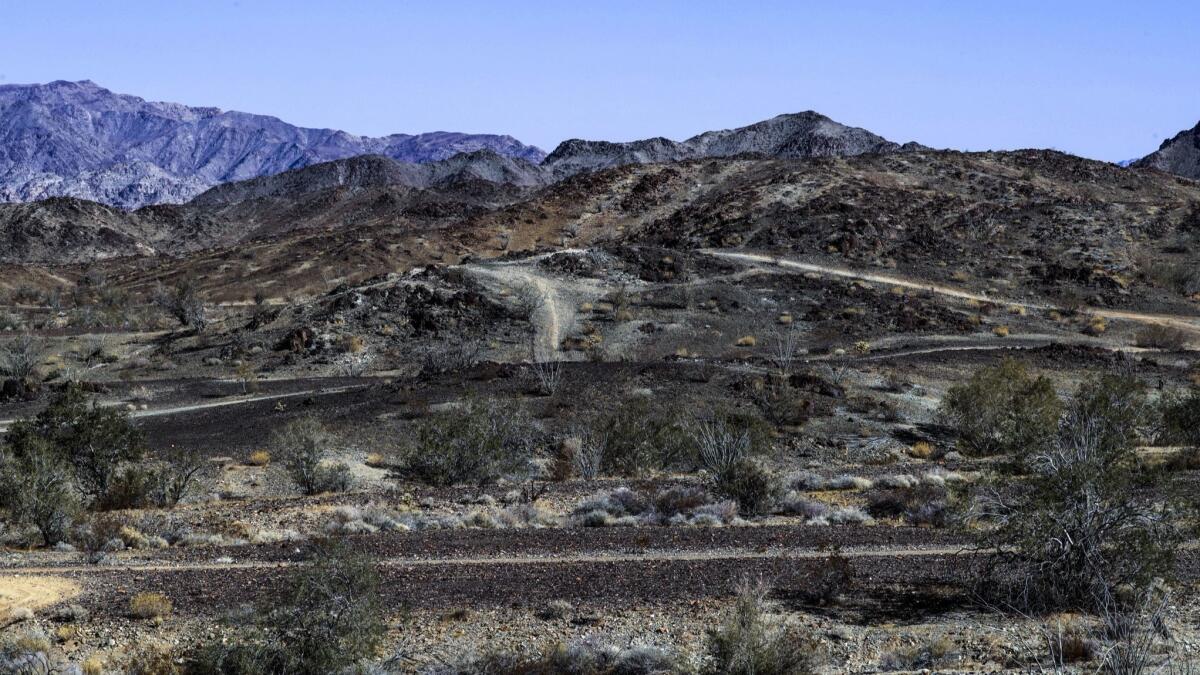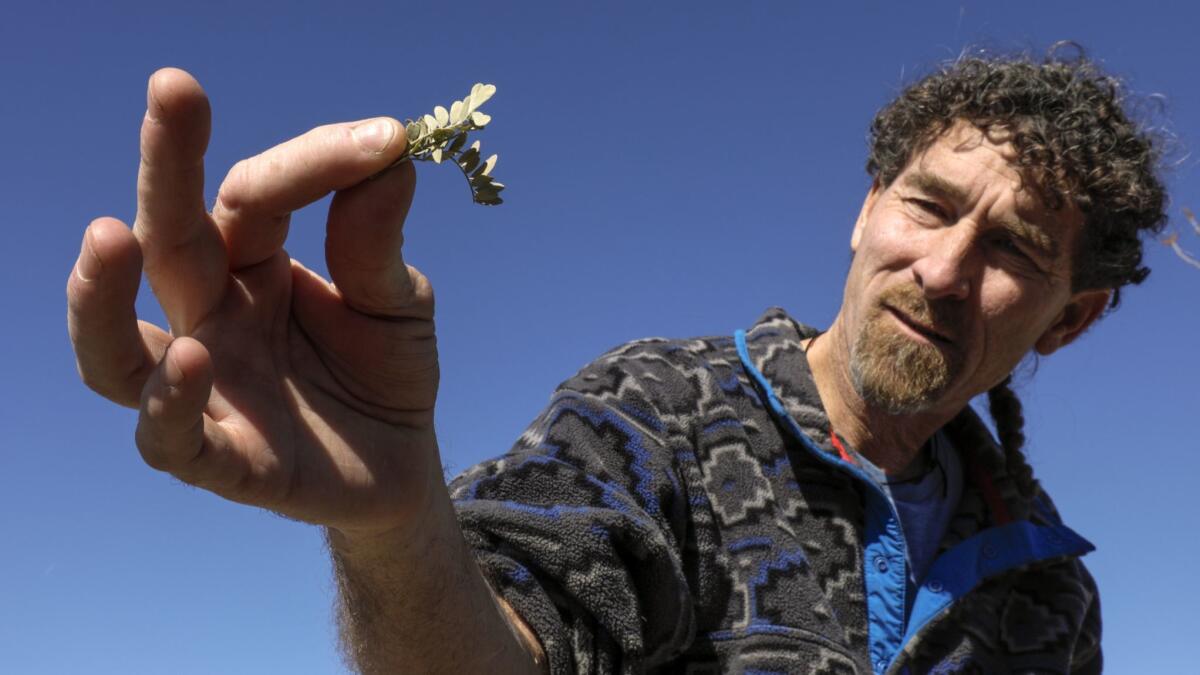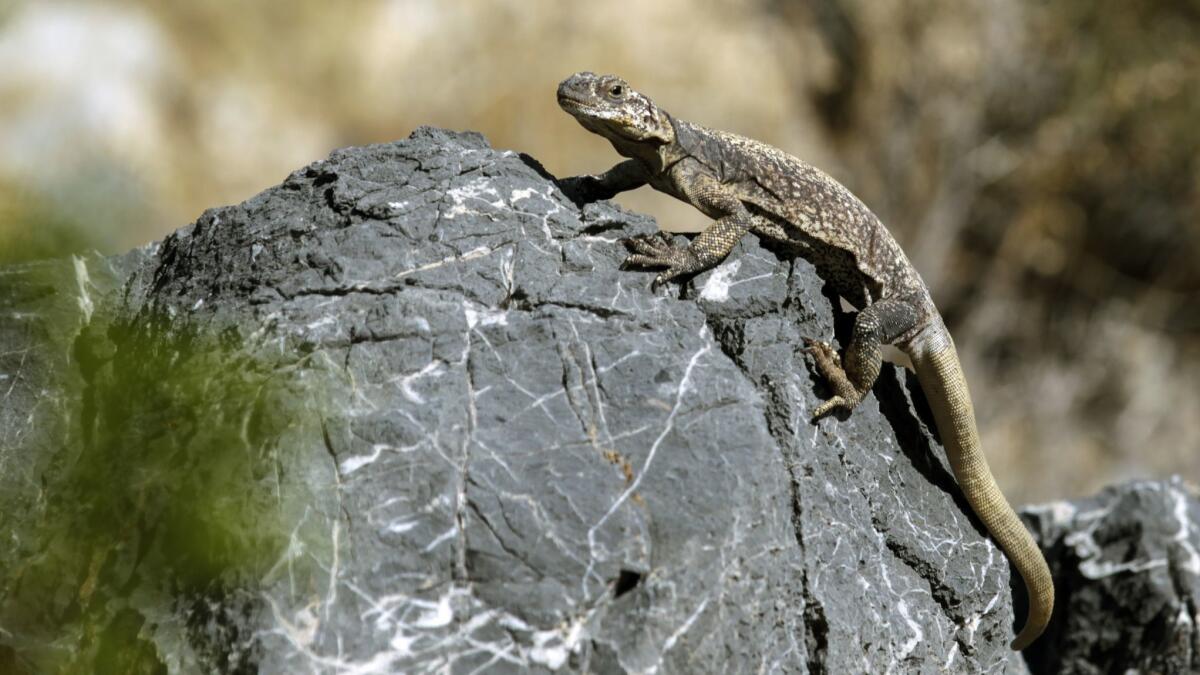By ordering new land-use plan, Trump could spark a fight in California deserts

It looks like a barren no man’s land, but the vast desert outside Indio, Calif., has many suitors.
Conservationists see its acres of creosote bush and cholla cactus as a rare habitat for tortoises, pronghorn antelope and an elusive variety of mule deer. Energy companies view its sunbaked plains and windswept ridgelines as prime perches for solar panels and wind turbines. Dirt tracks that wiggle across its sandy washes are testament to its popularity among off-road motorsports enthusiasts.
Until last year, all parties had reached something of an accord. Obama-era rules ensured that portions of California’s sunniest public lands would be reserved for conservation; other parts set aside for large-scale solar, wind and geothermal development and mining; and other sections designated for recreation.
But that delicate peace among competing interests could be upended.
In a stunning reversal, President Trump one year ago ordered the U.S. Bureau of Land Management to reopen study of the Desert Renewable Energy Conservation Plan and consider shrinking the areas it protects and expanding lands available for solar, wind, broadband infrastructure, mining, off-road vehicles and grazing.
Now, stakeholders are once again vying for control of some of the most sensitive and sought-after lands in the state — and the winners could determine whether California’s deserts become a hub for energy production at the expense of their unique plants and animals.
“Hornets are swarming because someone in Washington poked a hive in the California desert with a stick,” Greg Suba, conservation director for the California Native Plant Society, said. “We were making progress in striking a balance between development and conservation. Now, we’re spending all our time, energy and resources on dealing with chaos where there wasn’t any just a little while ago. It’s such a waste.”

The Obama administration spent eight years and considered more than 14,000 public comments in developing its plan for wind and solar projects and conservation. Unveiled in 2016, it set aside 3.9 million acres to be permanently protected, including the Silurian Valley and the Chuckwalla Bench. Another 1.4 million acres were designated areas of critical environmental concern. And 388,000 acres were designated appropriate for commercial-scale renewable energy projects.
Trump’s executive order directs the Bureau of Land Management to review all actions that could “potentially burden the development or use of domestically produced energy resources” on public lands. A subsequent executive order, issued in January, directs the bureau to foster rural broadband infrastructure projects in the areas.
Though the Obama plan had its critics, including green energy advocates who wanted more available land for development, the downright angry mood at ongoing public meetings intended to solicit comments on Trump’s action suggests a thorny path ahead for the BLM.
The opening remarks of BLM officials at a recent meeting in the Owens Valley community of Lone Pine left conservationists including Michael Prather, a botanist, seething: People are encouraged to submit comments in writing, with the caveat that the volume of comments received by the agency will not determine their importance.
“This system is rigged!” he shouted.
State leaders opposed to Trump’s action include U.S. Sen. Dianne Feinstein, California Secretary for Natural Resources John Laird, California Energy Commissioner Karen Douglas and the California State Lands Commission — all of whom believe it could hurt clean energy development by triggering drawn-out legal battles across 350 miles of California desert.
“Had the state been consulted,” Douglas said in an interview, “we would have informed the federal government that reopening the plan will only serve to create uncertainty and unneeded delays for renewable energy projects on public lands.”
Tom Egan, California desert representative for the nonprofit Defenders of Wildlife, summarized the concerns of many conservationists this way: “Reopening the plan in places such as Chuckwalla Bench means green energy, mining, corporate investors, grazing and off-roaders win. Conservation loses.”

Trump’s move was a surprise to many, and a happy one for green-energy advocates, who contend that concerns about environmental damage are exaggerated and remind critics that the power they provide can help fight global warming.
The Desert Renewable Energy Conservation Plan “fell short when it came to renewable energy by designating only a fraction of the area for development and ruling most of the remainder off-limits to renewable in perpetuity,” said Shannon Eddy, executive director of the Large-scale Solar Assn. It also “established exceedingly onerous siting requirements which make it difficult — if not impossible — for projects to build in areas designated for development.”
Nancy Rader, executive director of the California Wind Energy Assn., said her industry would “welcome the opportunity to revisit how wind is treated.”
“We are extremely unhappy with the existing plan, which prohibits wind energy production in most of the windiest areas in the desert,” she said.
County officials are only beginning to fathom the consequences of conflicts in desert lands that could be economically beneficial, or costly and bitterly contested.
A big concern in rural Inyo County — home to about 18,000 people as well as blue-ribbon trout streams, stark rock formations, marshlands and desert plains — is that new wind and solar projects on adjacent public lands would infringe on its own plans for where such facilities will be tolerated.
Kern County, a state leader in energy production on private land, argues that more wind development on public lands “is unnecessary for achieving renewable energy goals in the West.”
The Riverside County Board of Supervisors, however, has complained that the Obama administration’s plan inhibits economic growth and job creation by making energy projects too costly to build.
Criticism is not new to the BLM, which is obligated not simply to preserve the lands it administers, but make them productive as well. Those who contend it is too deferential to cattle ranchers and prospectors have long mocked the agency as the “Bureau of Livestock and Mining,” though ranchers often grumble about the arrogant “Bureau of Land Mismanagement.”
Critics both in and out of the BLM say the fault isn’t with its employees, but with the oscillating policies of an agency whipsawed by the shifting notions of presidential administrations and their appointees.
“The BLM has plenty of terrific lifetime public servants,” Frazier Haney, conservation director of the Mojave Desert Land Trust, said. “But at the end of the day, big land decisions are often not up to them, but to presidential administrations and high-level political appointees who can’t seem to make up their minds.”
Jerome Perez, the BLM’s California state director, would not go that far. “Each administration has its own priorities,” he said in an interview. “So, we’ll be taking a hard look” at the Desert Renewable Energy Conservation Plan.
Things in the desert got even more uncertain last week when Interior Secretary Ryan Zinke, a Trump appointee in charge of the BLM, stunned an audience at an annual energy conference in Houston by saying wind turbines have a “significant” carbon footprint and “chop up” thousands of birds each year. Solar projects, he added, are not compatible with wildlife, recreation or hunting.
The next day, however, Zinke announced that he had partnered with Congress on a proposed bipartisan bill to fund national park restoration projects with $18 billion in revenue derived from energy produced on public lands. It remains to be seen whether the bill, if approved, could serve as an inducement for investments in solar and wind projects.
This month, Zinke announced that the BLM would ease mining restrictions on 1.3 million acres of desert where it had been more tightly regulated, including public lands bordering Death Valley and Joshua Tree national parks.
Now, conservationists worry that industrial mining interests may push for road construction in areas of untrammeled wilderness.

At stake is some of the most vulnerable land in the state, such as the Chuckwalla Bench, an 800,000-acre expanse of cactus gardens and sandy washes fringed with ironwood and palo verde trees and framed by the Chuckwalla and Chocolate mountain ranges.
It has been used for grazing and as an off-road vehicle course. Mule deer — including the rare burro deer — and tortoises come to the area, about an hour east of Indio, for life-giving shade and occasional pools of rainwater. Prairie falcons and long-eared owls feed on rodents scampering over still-visible tracks left by Gen. George Patton’s tanks at a training camp during World War II.
In 1986, the BLM named the Chuckwalla Bench an “area of critical environmental concern.” The Obama-era plan added an extra layer of protection by designating a large portion of the region “national conservation lands,” not available for development. Such safeguards propelled a plan to establish a herd of federally endangered Sonoran pronghorn, a species not seen in California since 1945, there next year.
Now its future is uncertain.
Standing on a rocky crag overlooking the landscape of so much beauty and strife, Egan, of Defenders of Wildlife, shook his head and said, “The problem is that this relatively flat stretch of desert is ideal for pronghorn antelopes, as well as renewable energy development — but not both.”
Twitter: @LouisSahagun
More to Read
Sign up for Essential California
The most important California stories and recommendations in your inbox every morning.
You may occasionally receive promotional content from the Los Angeles Times.











